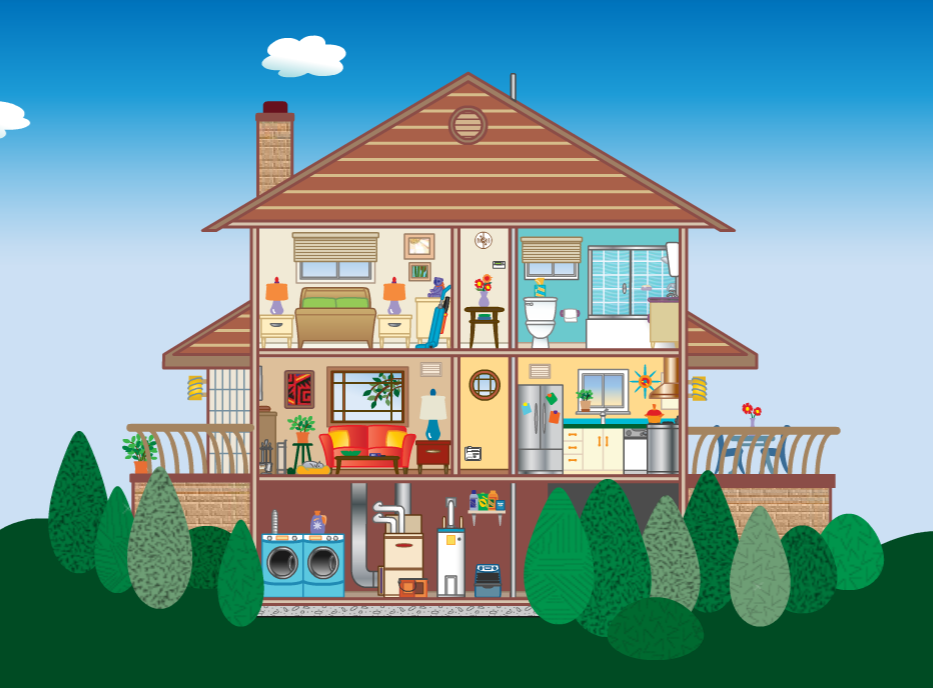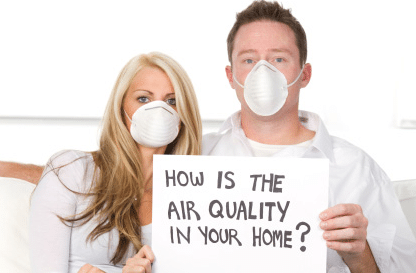Poor Air Quality. The Danger you can't see or smell.
Be safe at home, school, or work.

Kids spend most of their time in bed or at school!
Indoor air quality is particularly important for kids! According to research data, kids spend on average 9 hours in bed and 6 hours in school, everyday! Do your kid's bedroom and school have indoor air quality monitors to keep them safe?
Know what's in the house!
-

Top Polluters by Room
Kitchen & Hallways
Particles from cooking, toxic chemicals from detergents, aerosols and cleaning supplies.
Family Room, Living Room & Bedrooms
Radon from soil, toxins from candles, air fresheners, electronics, chemicals from furniture, flooring and bedding.
Bathrooms
Mold and mildew, toxic chemicals from cosmetics and toiletries.
-

Top Polluters by Type
Radon
From soil beneath the home and a variety of construction materials.
Chemicals
From furniture and flooring, sprays, cleaning supplies, toiletries, cosmetics, bedding, candles
Mold
Due to high humidity and lack of ventilation
More about Indoor Air Quality
What are Volatile Organic Compounds (VOCs)?
A Volatile Organic Compound (VOC) is defined as any compound containing carbon that can be readily vaporized, except methane. VOCs, are measured as the totality of its mixed gases indoor environments from cleaning and disinfecting products, paints, wood preservatives, carpeting, building materials, aerosols, insect repellents, microbial growth, and a host of other sources.
What symptoms are associated with high levels of VOCs?
At elevated levels, VOCs can cause eye, nose, and throat irritation; headaches, loss of coordination, nausea; damage to liver, kidneys, and central nervous system. Some organics (such as benzene) are suspected or known to cause cancer. Key signs or symptoms associated with exposure to elevated levels of VOCs include eye infections and irritation, nose and throat discomfort, headaches, allergic skin reactions, shortness of breath, signs of poisoning, nausea, vomiting, nose bleeding, fatigue, and dizziness.
At what levels should I worry about VOCs?
According to Indoor Air Quality standards such as the WELL Building Standard and the US Green Building Council (USGBC), VOC levels are considered elevated above 300-500 microgram/m3. Depending on the mix of the VOCs and their individual molecular weights, that can be translated to about 200 - 450 ppb (parts per billion); OSHA does not generally regulate the total combination of VOC compounds, instead it regulates limits for some specific VOC compounds
What is eCO2?
Carbon dioxide (CO2) equivalents, or for short eCO2, are derived from the measurements of the mixed gases, tVOCs, and describe the quality of indoor air in equivalent units of CO2. Traditionally, indoor air quality indices have been limited to the measurement of temperature, humidity, and carbon dioxide alone. eCO2, however, tracks changes in CO2 levels but also contains information about additional harmful mixed gases and odorous events. In contrast, a CO2 sensor detects just the exhaled CO2 from the room’s occupants.
What are considered elevated levels of CO2?
396 ppm (parts per million) was the mean average annualized global outdoor CO2 level reported at the end of August 2013 by NOAA. OSHA states that 1,000 ppm should be used as an upper limit for indoor levels, as a guideline for occupant comfort; a level higher than 1,000 ppm indicates inadequate ventilation. EPA testing recommends Carbon Dioxide levels to not exceed 800 ppm. American Society of Heating Refrigeration and Air Conditioning Engineers (ASHRAE) and the American Society of Testing and Materials (ASTM) suggest indoor levels should not exceed 700 ppm and 650 ppm above outdoor air, respectively. At levels above 2,000 ppm for an extended period of time complaints such as headaches, fatigue, and eye and throat irritation are typical and more widespread.
What is relative humidity?
Relative humidity (rH) is among the most common of indoor air environmental factors implicated in occupant discomfort. Elevated humidity has been shown to be associated with a worsened perception of Indoor Air Quality. High %rH is also an indicator of conditions favorable to mold and microbial growth.
What are recommended levels of relative humidity?
ASHRAE (American Society of Heating Refrigeration and Air-Conditioning Engineers) recommends a maximum of approximately 56%rH at 80°F and up to approximately 86%rH at 67°F (at standard atmospheric pressure). Clothing, radiant heat and many other factors influence the recommendations of this standard. This is based on their standard Graphical Comfort Zone Method. Per ASHRAE there are not any established lower humidity limits for thermal comfort. However, non-thermal comfort factors such as skin drying, irritation of mucus membranes, dryness of the eyes, and static electricity generation, may place limits on the acceptability of very low humidity environments.
What does the Mold Risk Indicator do?
The latest version of the lüft app includes a Mold Risk Indicator. The app analyzes the CURRENT condition of temperature and humidity and determines how likely it is that mold will develop. The Mold Risk is provided on a 5-level scale from very low to very high risk. Very low risk means it would take more than a year at this condition to develop mold, if any. Very high risk means it would only take three or fewer days for surface mold to develop. Please not that the device does not measure mold but indicates risk of mold developing. Additionally, other surfaces within the house, such as windows and outside walls, may begin to see mold developing
at lower risk levels. This is a function of the differential temperature and humidity conditions prevailing on any given wall or window surface as compared to readings taken in open air.
What to do when air quality index readings are elevated?
When your lüft monitor reports Radon levels above 2pCi/l for extended periods of time, please, contact a Radon Inspection and Mitigation professional. When VOC or eCO2 levels are persistently high, contact a certified Indoor Air Quality professional to seek advice or to perform additional testing. Improving home ventilation will temporarily mitigate the health concerns but it does not address a potential underlying that is giving rise to elevated readings..



